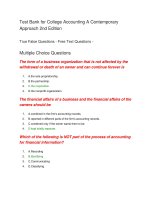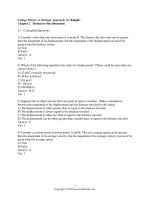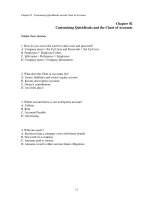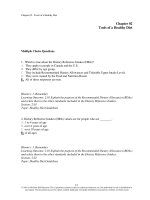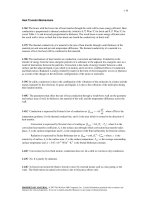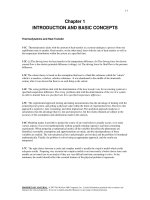College accounting a practical approach 13th edition jeffrey slater test bank
Bạn đang xem bản rút gọn của tài liệu. Xem và tải ngay bản đầy đủ của tài liệu tại đây (535.78 KB, 36 trang )
College Accounting, 13e (Slater)
Chapter 2 Debits and Credits: Analyzing and Recording Business Transactions
2.1 Learning Objective 2-1
1) Accounts Payable had a normal starting balance of $500. There were debit postings of $200 and credit
postings of $100 during the month. The ending balance is:
A) $400 credit.
B) $800 debit.
C) $400 debit.
D) $800 credit.
Answer: A
Diff: 2
LO: 2-1
AACSB: Analytical Thinking
Learning Outcome: Analyze and record transactions and their effects on the financial statements
2) The beginning balance in the Computers account was $3,000. The company purchased an additional
$1000 worth of computers. The ending balance in the account is:
A) debit of $2,000.
B) credit of $3,000.
C) debit of $4,000.
D) credit of $2,000.
Answer: C
Diff: 1
LO: 2-1
AACSB: Analytical Thinking
Learning Outcome: Analyze and record transactions and their effects on the financial statements
3) An accounting device used to record increases and decreases in individual assets, liabilities, capital,
revenue, expenses, and withdrawals is a(n):
A) chart of accounts.
B) account.
C) trial balance.
D) footing.
Answer: B
Diff: 2
LO: 2-1
AACSB: Reflective Thinking
Learning Outcome: Define accounting terms, accounting concepts and principles
1
Copyright © 2016 Pearson Education, Inc.
4) A formal account that has columns for date, explanation, posting reference, debit, and credit is called
the:
A) T account.
B) standard account form.
C) ledger.
D) chart of accounts.
Answer: B
Diff: 2
LO: 2-1
AACSB: Reflective Thinking
Learning Outcome: Define accounting terms, accounting concepts and principles
5) A ledger:
A) includes all company accounts and their balances.
B) can replace the financial statements.
C) is the same as a chart of accounts.
D) is known as a worksheet.
Answer: A
Diff: 1
LO: 2-1
AACSB: Reflective Thinking
Learning Outcome: Define accounting terms, accounting concepts and principles
6) The left side of any account is the:
A) debit side.
B) credit side.
C) ending balance.
D) beginning balance.
Answer: A
Diff: 1
LO: 2-1
AACSB: Reflective Thinking
Learning Outcome: Define accounting terms, accounting concepts and principles
7) The right side of any account is the:
A) debit side.
B) credit side.
C) ending balance.
D) beginning balance.
Answer: B
Diff: 1
LO: 2-1
AACSB: Reflective Thinking
Learning Outcome: Define accounting terms, accounting concepts and principles
2
Copyright © 2016 Pearson Education, Inc.
8) An account is said to have a debit balance if:
A) the footing of the debits exceeds the footing of the credits.
B) there are more entries on the debit side than on the credit side.
C) its normal balance is debit without regard to the amounts or number of entries on the debit side.
D) the last entry of the accounting period was posted on the debit side.
Answer: A
Diff: 2
LO: 2-1
AACSB: Analytical Thinking
Learning Outcome: Define accounting terms, accounting concepts and principles
9) The ledger is:
A) a group of accounts that records data from business transactions.
B) a tool used to insure that all accounts have normal balances.
C) a chronological record of the day's transactions.
D) a tool used to ensure that debits equal credits.
Answer: A
Diff: 1
LO: 2-1
AACSB: Reflective Thinking
Learning Outcome: Define accounting terms, accounting concepts and principles
10) The credit side is always the left side of the account.
Answer: FALSE
Diff: 1
LO: 2-1
AACSB: Reflective Thinking
Learning Outcome: Define accounting terms, accounting concepts and principles
11) A T account is used for demonstration purposes.
Answer: TRUE
Diff: 2
LO: 2-1
AACSB: Reflective Thinking
Learning Outcome: Define accounting terms, accounting concepts and principles
12) Explain the difference between expenses and withdrawals.
Answer: A withdrawal is used for recording the owner's withdrawal of company assets for personal use,
and not related to the business. Expenses are costs the company incurs in carrying on operations in its
effort to create revenue.
Diff: 2
LO: 2-1
AACSB: Written and Oral Communication
Learning Outcome: Define accounting terms, accounting concepts and principles
3
Copyright © 2016 Pearson Education, Inc.
2.2 Learning Objective 2-2
1) A compound entry is:
A) a transaction involving more than one debit and/or credit.
B) used to prepare the trial balance.
C) included on the balance sheet.
D) found on the income statement.
Answer: A
Diff: 1
LO: 2-2
AACSB: Reflective Thinking
Learning Outcome: Define accounting terms, accounting concepts and principles
2) The side that increases the account balance, by the rules of debit and credit, is said to be the:
A) debit side.
B) credit side.
C) normal balance.
D) None of these answers is correct.
Answer: C
Diff: 1
LO: 2-2
AACSB: Reflective Thinking
Learning Outcome: Define accounting terms, accounting concepts and principles
3) The Accounts Payable account is:
A) a capital, and it has a normal debit balance.
B) an expense, and it has a normal credit balance.
C) a liability, and it has a normal debit balance.
D) a liability, and it has a normal credit balance.
Answer: D
Diff: 1
LO: 2-2
AACSB: Reflective Thinking
Learning Outcome: Define accounting terms, accounting concepts and principles
4) An account that would be increased by a credit is:
A) Cash.
B) Prepaid Expense.
C) Utilities Expense.
D) Accounts Payable.
Answer: D
Diff: 1
LO: 2-2
AACSB: Reflective Thinking
Learning Outcome: Define accounting terms, accounting concepts and principles
4
Copyright © 2016 Pearson Education, Inc.
5) A debit may signify a(n):
A) increase in asset accounts.
B) increase in liability accounts.
C) increase in the revenue account.
D) decrease in expense accounts.
Answer: A
Diff: 1
LO: 2-2
AACSB: Reflective Thinking
Learning Outcome: Define accounting terms, accounting concepts and principles
6) A credit may signify a(n):
A) increase in assets.
B) decrease in liabilities.
C) increase in revenue.
D) increase in withdrawals.
Answer: C
Diff: 1
LO: 2-2
AACSB: Reflective Thinking
Learning Outcome: Define accounting terms, accounting concepts and principles
7) Which of the following types of accounts has a normal credit balance?
A) Withdrawals
B) Assets
C) Expenses
D) Revenues
Answer: D
Diff: 1
LO: 2-2
AACSB: Reflective Thinking
Learning Outcome: Define accounting terms, accounting concepts and principles
8) Which of the following types of accounts has a normal debit balance?
A) Withdrawals
B) Assets
C) Expenses
D) All of these answers are correct.
Answer: D
Diff: 1
LO: 2-2
AACSB: Reflective Thinking
Learning Outcome: Define accounting terms, accounting concepts and principles
5
Copyright © 2016 Pearson Education, Inc.
9) When recording transactions in two or more accounts and the totals of the debits and credits are equal,
it is called:
A) debiting.
B) crediting.
C) balancing.
D) double-entry bookkeeping.
Answer: D
Diff: 1
LO: 2-2
AACSB: Reflective Thinking
Learning Outcome: Define accounting terms, accounting concepts and principles
10) Which of the following groups of accounts have a normal debit balance?
A) Revenue, liabilities, and capital
B) Assets, capital, and withdrawals
C) Liabilities, expenses, and assets
D) Assets, expenses, and withdrawals
Answer: D
Diff: 2
LO: 2-2
AACSB: Reflective Thinking
Learning Outcome: Define accounting terms, accounting concepts and principles
11) Which of the following accounts would be increased by a debit?
A) Cash
B) Accounts Payable
C) Capital
D) Service Revenue
Answer: A
Diff: 1
LO: 2-2
AACSB: Reflective Thinking
Learning Outcome: Define accounting terms, accounting concepts and principles
12) What is a proper entry to show the owner making an investment in the company?
A) A credit to Cash and a debit to Capital
B) A debit to Cash and a credit to Capital
C) A debit to Cash and a credit to Revenue
D) A credit to Cash and a debit to Revenue
Answer: B
Diff: 1
LO: 2-2
AACSB: Reflective Thinking
Learning Outcome: Analyze and record transactions and their effects on the financial statements
6
Copyright © 2016 Pearson Education, Inc.
13) Which of the following entries would be used to record the billing of fees earned?
A) Debit Accounts Receivable and credit Rental Fees
B) Credit Cash and credit Rental Fees
C) Debit Accounts Payable and credit Rental Fees
D) Debit Cash and debit Rental Fees
Answer: A
Diff: 2
LO: 2-2
AACSB: Analytical Thinking
Learning Outcome: Analyze and record transactions and their effects on the financial statements
14) Which of the statements of the rules of debit and credit is true?
A) Decrease Accounts Receivable with a credit and the normal balance is a credit.
B) Increase Accounts Payable with a credit and the normal balance is a credit.
C) Increase Revenue with a debit and the normal balance is a debit.
D) Decrease Cash with a debit and the normal balance is a debit.
Answer: B
Diff: 2
LO: 2-2
AACSB: Analytical Thinking
Learning Outcome: Analyze and record transactions and their effects on the financial statements
15) Which of the following entries records the investment of cash by John, owner of a sole proprietorship?
A) Debit John, Capital; credit Cash
B) Debit Cash; credit Revenue
C) Debit John, Withdrawals; credit Cash
D) Debit Cash; credit John, Capital
Answer: D
Diff: 2
LO: 2-2
AACSB: Analytical Thinking
Learning Outcome: Analyze and record transactions and their effects on the financial statements
16) Dennis, owner of Dennis's Golf Center, withdrew $900 in cash from the business. Record the
transaction by:
A) debiting Dennis, Withdrawals, $900; crediting Cash, $900.
B) debiting Accounts Receivable, $900; crediting Cash, $900.
C) debiting Expense, $900; crediting Cash, $900.
D) debiting Dennis, Withdrawals, $900; crediting Dennis, Capital, $900.
Answer: A
Diff: 2
LO: 2-2
AACSB: Analytical Thinking
Learning Outcome: Analyze and record transactions and their effects on the financial statements
7
Copyright © 2016 Pearson Education, Inc.
17) The entry to record Tom's payment of a home telephone bill is:
A) debit Accounts Payable; credit Telephone Expense.
B) debit Tom, Withdrawals; credit Cash.
C) debit Telephone Expense; credit Cash.
D) debit Tom, Withdrawals; credit Accounts Payable.
Answer: B
Diff: 2
LO: 2-2
AACSB: Analytical Thinking
Learning Outcome: Analyze and record transactions and their effects on the financial statements
18) Extreme Home bought painting equipment on account for $3,000. The entry would include:
A) debit to Supplies Expense, $3,000; credit to Cash, $3,000.
B) debit to Equipment, $3,000; credit to Cash, $3,000
C) debit to Equipment, $3,000; credit to Accounts Payable, $3,000.
D) debit to Supplies Expense, $3,000; credit to Accounts Payable, $3,000.
Answer: C
Diff: 2
LO: 2-2
AACSB: Analytical Thinking
Learning Outcome: Analyze and record transactions and their effects on the financial statements
19) The owner of BobCats R Us paid his personal MasterCard bill using a company check. The correct
entry to record the transaction is:
A) credit Cash; debit Capital.
B) credit Cash; debit Supplies Expense.
C) credit Cash; debit Withdrawals.
D) credit Cash; debit Accounts Receivable.
Answer: C
Diff: 2
LO: 2-2
AACSB: Analytical Thinking
Learning Outcome: Analyze and record transactions and their effects on the financial statements
20) Carrie flew to San Francisco on a business trip that will be reimbursed by her employer. The purchase
price of the ticket was $500 and it was bought on account. The entry to record the transaction is:
A) debit Accounts Payable, $500; credit Travel Expense, $500.
B) debit Capital, $500; credit Accounts Payable, $500.
C) debit Travel Expense, $500; credit Accounts Payable, $500.
D) debit Travel Expense, $500; credit Cash, $500.
Answer: C
Diff: 2
LO: 2-2
AACSB: Analytical Thinking
Learning Outcome: Analyze and record transactions and their effects on the financial statements
8
Copyright © 2016 Pearson Education, Inc.
21) The Accounts Receivable account has total debit postings of $2,000 and credit postings of $1,200. The
balance of the account is:
A) $800 debit.
B) $800 credit.
C) $2,600 credit.
D) $2,600 debit.
Answer: A
Diff: 2
LO: 2-2
AACSB: Analytical Thinking
Learning Outcome: Analyze and record transactions and their effects on the financial statements
22) The Salaries Payable account has total debit postings of $800 and credit postings of $1,500. The ending
balance of the account is:
A) $2,300 debit.
B) $700 credit.
C) $2,300 credit.
D) $700 debit.
Answer: B
Diff: 2
LO: 2-2
AACSB: Analytical Thinking
Learning Outcome: Analyze and record transactions and their effects on the financial statements
23) Office Supplies had a normal starting balance of $75. There were debit postings of $80 and credit
postings of $60 during the month. The ending balance of the account is:
A) $55 debit.
B) $55 credit.
C) $95 debit.
D) $95 credit.
Answer: C
Diff: 2
LO: 2-2
AACSB: Analytical Thinking
Learning Outcome: Analyze and record transactions and their effects on the financial statements
24) Cash has a normal balance of $1,100. After collecting $800, the balance in the account is:
A) debit $300.
B) debit $1,900.
C) credit $300.
D) credit $1,900.
Answer: B
Diff: 2
LO: 2-2
AACSB: Analytical Thinking
Learning Outcome: Analyze and record transactions and their effects on the financial statements
9
Copyright © 2016 Pearson Education, Inc.
25) The beginning balance in Cash was $4,000. Additional cash of $2,000 was received. Checks were
written totaling $2,500. The ending balance in cash is:
A) $2,000.
B) $6,000.
C) $4,500.
D) $3,500.
Answer: D
Diff: 2
LO: 2-2
AACSB: Analytical Thinking
Learning Outcome: Analyze and record transactions and their effects on the financial statements
26) A credit to an asset account was posted as a credit to the Capital account. This error would cause:
A) assets to be overstated.
B) liabilities to be overstated.
C) capital to be understated.
D) Both A and C are correct.
Answer: A
Diff: 2
LO: 2-2
AACSB: Analytical Thinking
Learning Outcome: Analyze and record transactions and their effects on the financial statements
27) A credit to a liability account was posted as a credit to an expense account. This error would cause:
A) assets to be overstated.
B) liabilities to be overstated.
C) expenses to be overstated.
D) liabilities to be understated.
Answer: D
Diff: 2
LO: 2-2
AACSB: Analytical Thinking
Learning Outcome: Analyze and record transactions and their effects on the financial statements
28) A debit to an expense account was posted as a debit to a revenue account. This error would cause:
A) assets to be overstated.
B) liabilities to be overstated.
C) revenue to be understated.
D) None of the above is correct.
Answer: C
Diff: 2
LO: 2-2
AACSB: Analytical Thinking
Learning Outcome: Analyze and record transactions and their effects on the financial statements
10
Copyright © 2016 Pearson Education, Inc.
29) A credit to an asset account was posted as a credit to a revenue account. This error would cause:
A) assets to be overstated.
B) revenue to be overstated.
C) expenses to be overstated.
D) Both A and B are correct.
Answer: D
Diff: 2
LO: 2-2
AACSB: Analytical Thinking
Learning Outcome: Analyze and record transactions and their effects on the financial statements
30) A debit to a liability account was posted as a debit to the Capital account. This error would cause:
A) assets to be overstated.
B) liabilities to be overstated.
C) capital to be overstated.
D) None of the above is correct.
Answer: B
Diff: 2
LO: 2-2
AACSB: Analytical Thinking
Learning Outcome: Analyze and record transactions and their effects on the financial statements
31) A debit to an asset account was posted as a debit to an expense account. This error would cause:
A) liabilities to be overstated.
B) expenses to be overstated.
C) assets to be understated.
D) Both B and C are correct.
Answer: D
Diff: 2
LO: 2-2
AACSB: Analytical Thinking
Learning Outcome: Analyze and record transactions and their effects on the financial statements
32) A debit to a liability account was posted as a debit to a revenue account. This error would cause:
A) revenues to be understated.
B) liabilities to be understated.
C) revenue to be overstated.
D) None of the above is correct.
Answer: A
Diff: 2
LO: 2-2
AACSB: Analytical Thinking
Learning Outcome: Analyze and record transactions and their effects on the financial statements
11
Copyright © 2016 Pearson Education, Inc.
33) A debit to an asset account was posted as a debit to a liability account. This error would cause:
A) assets to be understated.
B) liabilities to be overstated.
C) capital to be understated.
D) None of the above is correct.
Answer: A
Diff: 2
LO: 2-2
AACSB: Analytical Thinking
Learning Outcome: Analyze and record transactions and their effects on the financial statements
34) The chart of accounts:
A) is a numbered list of all of the business's accounts.
B) allows accounts to be located quickly.
C) can be expanded as the business grows.
D) All of the above are correct.
Answer: D
Diff: 1
LO: 2-2
AACSB: Reflective Thinking
Learning Outcome: Define accounting terms, accounting concepts and principles
35) A credit to an asset account was posted as a credit to a liability account. This error would cause:
A) assets to be understated.
B) liabilities to be overstated.
C) capital to be understated.
D) None of the above is correct.
Answer: B
Diff: 2
LO: 2-2
AACSB: Analytical Thinking
Learning Outcome: Analyze and record transactions and their effects on the financial statements
36) The business incurred an expense and paid it immediately. To record this:
A) an expense is debited and a liability is credited.
B) an expense is debited and an asset is credited.
C) an asset is debited and asset is credited.
D) None of these is correct.
Answer: B
Diff: 2
LO: 2-2
AACSB: Analytical Thinking
Learning Outcome: Analyze and record transactions and their effects on the financial statements
12
Copyright © 2016 Pearson Education, Inc.
37) The business provided services to a credit customer. To record this:
A) an asset is debited and a liability is credited.
B) an asset is debited and a revenue is credited.
C) an expense is debited and Capital is credited.
D) None of these is correct.
Answer: B
Diff: 2
LO: 2-2
AACSB: Analytical Thinking
Learning Outcome: Analyze and record transactions and their effects on the financial statements
38) The owner invested personal equipment in the business. To record this transaction:
A) debit Equipment and credit Revenue.
B) debit Accounts Payable and credit Equipment.
C) debit Equipment and credit Capital.
D) credit Equipment and debit Capital.
Answer: C
Diff: 2
LO: 2-2
AACSB: Analytical Thinking
Learning Outcome: Analyze and record transactions and their effects on the financial statements
39) Which of the following errors would cause the trial balance to be out of balance?
A) An entry is posted twice.
B) An entry is not posted at all.
C) A debit is entered as $500 and the credit is entered at $5,000.
D) None of these answers is correct.
Answer: C
Diff: 3
LO: 2-2
AACSB: Analytical Thinking
Learning Outcome: Analyze and record transactions and their effects on the financial statements
40) The business bought supplies with cash. To record this:
A) an expense is debited and a liability is credited.
B) an asset is debited and an asset is credited.
C) an asset is debited and a liability is credited.
D) None of these is correct.
Answer: B
Diff: 1
LO: 2-2
AACSB: Analytical Thinking
Learning Outcome: Analyze and record transactions and their effects on the financial statements
13
Copyright © 2016 Pearson Education, Inc.
41) A liability would be credited and an expense debited if:
A) the business paid a creditor.
B) the business incurred an expense and did not pay the expense immediately.
C) the business bought supplies on account.
D) the business bought supplies for cash.
Answer: B
Diff: 2
LO: 2-2
AACSB: Analytical Thinking
Learning Outcome: Analyze and record transactions and their effects on the financial statements
42) One asset would be debited and another credited if:
A) the business provided services to a cash customer.
B) the business paid a creditor.
C) the business bought supplies paying cash.
D) the business provided services to a credit customer.
Answer: C
Diff: 2
LO: 2-2
AACSB: Analytical Thinking
Learning Outcome: Analyze and record transactions and their effects on the financial statements
43) An asset would be debited and a liability credited if:
A) the business bought supplies for cash.
B) the business incurred an expense and paid it.
C) the business bought equipment on account.
D) None of these is correct.
Answer: C
Diff: 2
LO: 2-2
AACSB: Analytical Thinking
Learning Outcome: Analyze and record transactions and their effects on the financial statements
44) What would be the effect on the accounts if the business provided services to a customer on account?
A) An asset would be debited and an expense credited.
B) Capital would be debited and Revenue credited.
C) An asset would be debited and Revenue credited.
D) An asset would be debited and Capital credited.
Answer: C
Diff: 1
LO: 2-2
AACSB: Analytical Thinking
Learning Outcome: Analyze and record transactions and their effects on the financial statements
14
Copyright © 2016 Pearson Education, Inc.
45) What would be the effect on the accounts if the business provided services to a customer collecting
cash?
A) An asset would be debited and an expense debited.
B) Capital would be credited and Revenue credited.
C) An asset would be debited and Revenue credited.
D) An asset would be debited and Capital credited.
Answer: C
Diff: 1
LO: 2-2
AACSB: Analytical Thinking
Learning Outcome: Analyze and record transactions and their effects on the financial statements
46) What would be the effect on the accounts if the owner withdrew cash?
A) An asset would be credited and an expense credited.
B) Withdrawals would be debited and an asset credited.
C) An asset would be debited and a revenue credited.
D) An expense would be debited and Capital credited.
Answer: B
Diff: 1
LO: 2-2
AACSB: Analytical Thinking
Learning Outcome: Analyze and record transactions and their effects on the financial statements
47) What would be the effect on the accounts if the business purchased office supplies for cash?
A) An asset would be debited and an expense debited.
B) Expense would be debited and Revenue credited.
C) An asset would be debited and Revenue credited.
D) An asset would be debited and an asset credited.
Answer: D
Diff: 1
LO: 2-2
AACSB: Analytical Thinking
Learning Outcome: Analyze and record transactions and their effects on the financial statements
48) What would be the effect on the accounts if the business received the telephone bill but did not pay it
immediately?
A) An expense would be debited and a liability credited.
B) Capital would be debited and Revenue credited.
C) An expense would be debited and an asset credited.
D) An asset would be debited and Capital credited.
Answer: A
Diff: 2
LO: 2-2
AACSB: Analytical Thinking
Learning Outcome: Analyze and record transactions and their effects on the financial statements
15
Copyright © 2016 Pearson Education, Inc.
49) An account that would be increased by a debit is:
A) Cash.
B) Fees Earned.
C) Capital.
D) Accounts Payable.
Answer: A
Diff: 1
LO: 2-2
AACSB: Analytical Thinking
Learning Outcome: Analyze and record transactions and their effects on the financial statements
50) Which of the following groups of accounts have a normal credit balance?
A) Revenue, liabilities, and capital
B) Assets, capital, and withdrawals
C) Liabilities, expenses, and assets
D) Assets, expenses, and withdrawals
Answer: A
Diff: 1
LO: 2-2
AACSB: Reflective Thinking
Learning Outcome: Define accounting terms, accounting concepts and principles
51) A chart of accounts:
A) is set up in alphabetical order.
B) is a list of customer accounts.
C) is a listing of all the accounts used by a company.
D) All of the above are correct.
Answer: C
Diff: 2
LO: 2-2
AACSB: Reflective Thinking
Learning Outcome: Define accounting terms, accounting concepts and principles
52) Accounts receivable decrease on the debit side of the account.
Answer: FALSE
Diff: 1
LO: 2-2
AACSB: Reflective Thinking
Learning Outcome: Analyze and record transactions and their effects on the financial statements
53) In accrual basis accounting, revenues are only recorded when cash is received.
Answer: FALSE
Diff: 1
LO: 2-2
AACSB: Reflective Thinking
Learning Outcome: Define accounting terms, accounting concepts and principles
16
Copyright © 2016 Pearson Education, Inc.
54) Cash is credited when the business makes a payment for supplies.
Answer: TRUE
Diff: 1
LO: 2-2
AACSB: Analytical Thinking
Learning Outcome: Analyze and record transactions and their effects on the financial statements
55) Debits must always equal credits in a transaction or journal entry.
Answer: TRUE
Diff: 1
LO: 2-2
AACSB: Reflective Thinking
Learning Outcome: Define accounting terms, accounting concepts and principles
56) The debit side of all accounts decreases the balance and the credit side increases all accounts.
Answer: FALSE
Diff: 2
LO: 2-2
AACSB: Analytical Thinking
Learning Outcome: Define accounting terms, accounting concepts and principles
57) The debit side is always the left side of the account.
Answer: TRUE
Diff: 1
LO: 2-2
AACSB: Reflective Thinking
Learning Outcome: Define accounting terms, accounting concepts and principles
58) A transaction that involves more than one credit or more than one debit is called a compound entry.
Answer: TRUE
Diff: 2
LO: 2-2
AACSB: Reflective Thinking
Learning Outcome: Analyze and record transactions and their effects on the financial statements
59) The side of an account that increases the balance is always the same as the normal balance side.
Answer: TRUE
Diff: 1
LO: 2-2
AACSB: Reflective Thinking
Learning Outcome: Analyze and record transactions and their effects on the financial statements
60) Double-entry accounting requires transactions to affect two or more accounts, and the total of the
debits and credits must equal.
Answer: TRUE
Diff: 2
LO: 2-2
AACSB: Reflective Thinking
Learning Outcome: Analyze and record transactions and their effects on the financial statements
17
Copyright © 2016 Pearson Education, Inc.
61) Two accounts are affected in every transaction.
Answer: TRUE
Diff: 2
LO: 2-2
AACSB: Reflective Thinking
Learning Outcome: Analyze and record transactions and their effects on the financial statements
62) Withdrawals increase on the credit side of the account.
Answer: FALSE
Diff: 1
LO: 2-2
AACSB: Reflective Thinking
Learning Outcome: Analyze and record transactions and their effects on the financial statements
63) After deciding which accounts are affected, the next step in analyzing a transaction is to determine to
which categories the accounts belong.
Answer: TRUE
Diff: 1
LO: 2-2
AACSB: Reflective Thinking
Learning Outcome: Analyze and record transactions and their effects on the financial statements
64) Equipment is an example of a capital account.
Answer: FALSE
Diff: 1
LO: 2-2
AACSB: Reflective Thinking
Learning Outcome: Define accounting terms, accounting concepts and principles
65) A compound entry is when more than one transaction occurs.
Answer: FALSE
Diff: 2
LO: 2-2
AACSB: Reflective Thinking
Learning Outcome: Define accounting terms, accounting concepts and principles
66) When the owner invests personal equipment in the business, cash is decreased.
Answer: FALSE
Diff: 1
LO: 2-2
AACSB: Analytical Thinking
Learning Outcome: Analyze and record transactions and their effects on the financial statements
67) Accounts Receivable indicates amounts owed to us by our clients or creditors.
Answer: FALSE
Diff: 1
LO: 2-2
AACSB: Reflective Thinking
Learning Outcome: Define accounting terms, accounting concepts and principles
18
Copyright © 2016 Pearson Education, Inc.
68) Accounts Payable indicates monies owed to us by our clients or customers.
Answer: FALSE
Diff: 1
LO: 2-2
AACSB: Reflective Thinking
Learning Outcome: Define accounting terms, accounting concepts and principles
69) Expenses are recorded when incurred.
Answer: TRUE
Diff: 1
LO: 2-2
AACSB: Reflective Thinking
Learning Outcome: Define accounting terms, accounting concepts and principles
70) Accounts Payable is an asset account that is increased on the credit side.
Answer: FALSE
Diff: 1
LO: 2-2
AACSB: Reflective Thinking
Learning Outcome: Define accounting terms, accounting concepts and principles
71) The Accounts Receivable account is increased by a debit.
Answer: TRUE
Diff: 1
LO: 2-2
AACSB: Analytical Thinking
Learning Outcome: Define accounting terms, accounting concepts and principles
72) Why is Revenue increased on the Credit side? (Explain as it pertains to the expanded accounting
equation and its relationship to Owner's Equity.)
Answer: Revenue is an increase to owner's equity; Capital is increased on the credit side.
Diff: 1
LO: 2-2
AACSB: Written and Oral Communication
Learning Outcome: Define accounting terms, accounting concepts and principles
19
Copyright © 2016 Pearson Education, Inc.
73) Selected accounts from the ledger of Thomas Company appear below. For each account, indicate the
following:
a. In the first column at right, indicate the type of each account using the following abbreviations:
Asset - A
Revenue - R
None of the above - N Liability - L
Expense - E
b. In the second column, indicate the normal balance of the account by inserting a Dr. or Cr.
Account
1. Office Supplies
2. Accounts Receivable
3. Fees Earned
4. Thomas, Withdrawals
5. Accounts Payable
6. Salaries Expense
7. Thomas, Capital
8. Accounts Receivable
9. Equipment
10. Telephone Expense
Answer:
Account
1. Office Supplies
2. Accounts Receivable
3. Fees Earned
4. Thomas, Withdrawals
5. Accounts Payable
6. Salaries Expense
7. Thomas, Capital
8. Accounts Receivable
9. Equipment
10. Telephone Expense
Type of
Account
______
______
______
______
______
______
______
______
______
______
Normal Balance
______
______
______
______
______
______
______
______
______
______
Type of
Account
A
A
R
N
L
E
N
A
A
E
Normal Balance
Dr
Dr
Cr
Dr
Cr
Dr
Cr
Dr
Dr
Dr
Diff: 2
LO: 2-2
AACSB: Reflective Thinking
Learning Outcome: Define accounting terms, accounting concepts and principles
20
Copyright © 2016 Pearson Education, Inc.
74) Identify the normal balance for each of the following accounts by placing a Dr. (debit) or a Cr. (credit)
in the space provided.
________ 1. Computer
________ 2. M. Bryant, Withdrawals
________ 3. M. Bryant, Capital
________ 4. Legal Fees Earned
________ 5. Cash
________ 6. Accounts Receivable
________ 7. Accounts Payable
________ 8. Rent Expense
________ 9. Office Equipment
________ 10. Supplies
Answer:
1. Dr.
2. Dr.
3. Cr.
4. Cr.
5. Dr.
6. Dr.
7. Cr.
8. Dr.
9. Dr.
10. Dr.
Diff: 2
LO: 2-2
AACSB: Reflective Thinking
Learning Outcome: Define accounting terms, accounting concepts and principles
21
Copyright © 2016 Pearson Education, Inc.
75) Identify whether a debit or credit would be correct for each of the following account changes. Use a
Dr. (debit) or Cr. (credit) in the space provided.
________ 1. Increase Delivery Van
________ 2. Increase Accounts Receivable
________ 3. Increase Accounts Payable
________ 4. Increase Salaries Expense
________ 5. Increase Service Fees Earned
________ 6. Decrease Cash
________ 7. Increase S. McCrae, Capital
________ 8. Increase S. McCrae, Withdrawals
________ 9. Increase Rent Expense
________ 10. Increase Equipment
Answer:
1. Dr.
2. Dr.
3. Cr.
4. Dr.
5. Cr.
6. Cr.
7. Cr.
8. Dr.
9. Dr.
10. Dr.
Diff: 2
LO: 2-2
AACSB: Analytical Thinking
Learning Outcome: Analyze and record transactions and their effects on the financial statements
22
Copyright © 2016 Pearson Education, Inc.
76) Below is a chart of accounts. Following is a series of transactions. Indicate for each transaction the
accounts that should be debited and credited by inserting the proper account number in the space
provided.
111 Cash
112 Accounts Receivable
121 Office Equipment
211 Accounts Payable
311 R. Andrews, Capital
Debit
Credit
________ ________
________ ________
________ ________
________ ________
________ ________
________ ________
________ ________
________ ________
________ ________
________ ________
Answer:
1. 121 111
2. 511 111
3. 111 311
4. 111 112
5. 112 411
6. 211 111
7. 111 112
8. 312 111
9. 513 111
10. 512 111
312 R. Andrews, Withdrawals
411 Service Fees Earned
511 Salaries Expense
512 Rent Expense
513 Advertising Expense
Transaction
1. Purchased office equipment with cash.
2. Paid salaries for the week.
3. Invested additional cash in the business.
4. Received cash on account.
5. Billed a client on account for services performed.
6. Paid accounts payable.
7. Collected accounts receivable.
8. Withdrew cash for personal use.
9. Paid advertising expense.
10. Paid rent expense for the month.
Diff: 2
LO: 2-2
AACSB: Analytical Thinking
Learning Outcome: Analyze and record transactions and their effects on the financial statements
23
Copyright © 2016 Pearson Education, Inc.
77) A chart of accounts is below. Following is a series of transactions. Indicate for each transaction the
accounts that should be debited and credited by inserting the proper account number in the space
provided.
111 Cash
112 Accounts Receivable
121 Delivery Equipment
211 Accounts Payable
311 C. Webster, Capital
Debit
Credit
________ ________
________ ________
________ ________
________ ________
________ ________
________ ________
________ ________
________ ________
________ ________
________ ________
Answer:
1. 111 311
2. 111 411
3. 112 411
4. 211 111
5. 111 112
6. 312 111
7. 513 111
8. 512 111
9. 121 211
10. 511 111
312 C. Webster, Withdrawals
411 Delivery Fees Earned
511 Salaries Expense
512 Rent Expense
513 Advertising Expense
514 Gas Expense
Transaction
1. Invested cash in the business.
2. Received cash for delivery services performed.
3. Billed a customer for services performed.
4. Paid accounts payable.
5. Collected accounts receivable.
6. Withdrew cash for personal use.
7. Paid advertising expense.
8. Paid rent expense for the month.
9. Purchased delivery equipment on account.
10. Paid salaries for the week.
Diff: 2
LO: 2-2
AACSB: Analytical Thinking
Learning Outcome: Analyze and record transactions and their effects on the financial statements
24
Copyright © 2016 Pearson Education, Inc.
78) The following transactions occurred during June for Campus Cycle Shop. Record the transactions
below in the T accounts. Place the letter of the transaction next to the entry. Foot and calculate the ending
balances of the T accounts where appropriate.
a. Tyler invested $6500 in the bike service from his personal savings account.
b. Bought office equipment for cash, $900.
c. Performed bike service for a customer on account, $1,000.
d. Company cell phone bill received, but not paid, $80.
e. Collected $500 from customer in transaction c.
f. Tyler withdrew $300 for personal use.
Answer:
Diff: 2
LO: 2-2
AACSB: Analytical Thinking
Learning Outcome: Analyze and record transactions and their effects on the financial statements
25
Copyright © 2016 Pearson Education, Inc.
